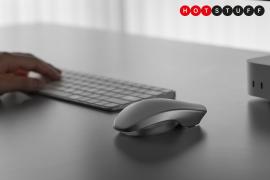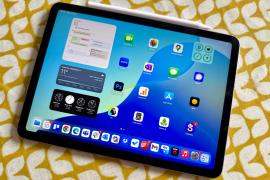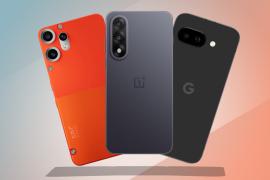Best iPhone in 2025 ranked from best to worst
Which iPhone should you choose? This guide will help you find out. Here's the good and the bad about every available Apple smartphone
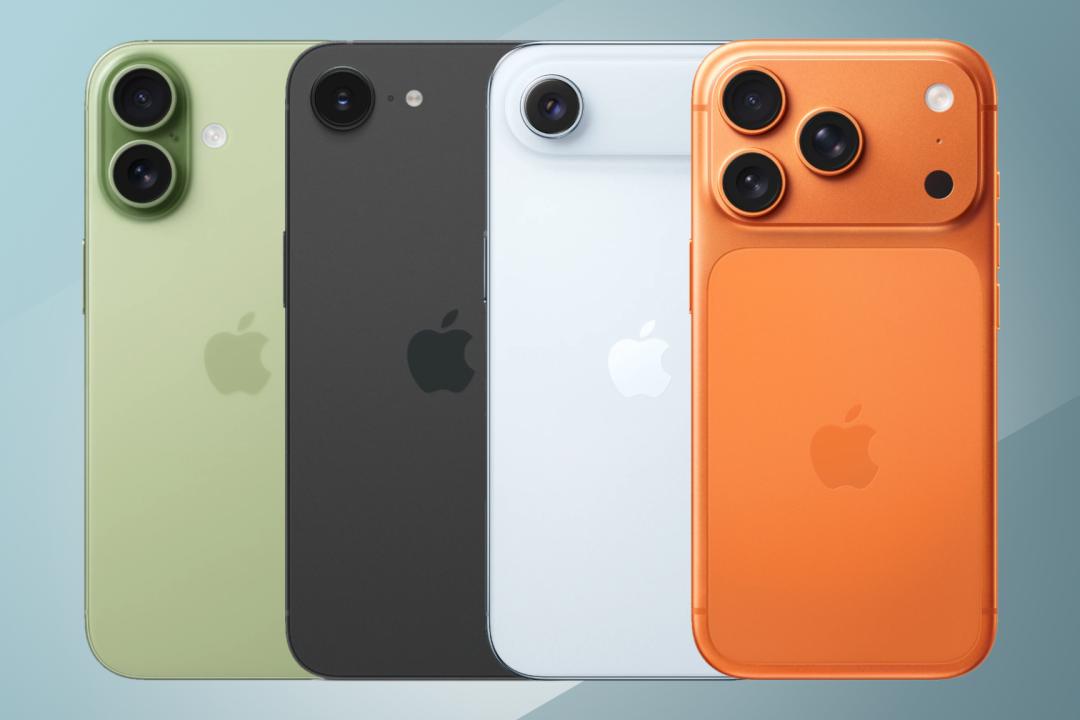
Choosing the best iPhone used to be easy; you just had to choose the colour and the storage capacity. It was guaranteed to be among the best smartphones on sale. But now, things are not so simple. From E to Plus to Pro to Pro Max to Air, Apple’s flagship phone ships in more variants than ever before.
And just to muddy the waters further, the mobile maker still sells a few of its former headline handsets from previous generations, as well as the entry-level SE for buyers on a budget.
So there’s an Apple smartphone for everyone. The tricky thing is knowing how to pick it. Not sure where to start? We’ve set out the good, the bad and the things to note about the key iPhone models currently available to buy to help you decide.
Note that we’ve left the iPhone 16 and 14 in this list for now. They’ve gone end-of-life and have been replaced by newer models, but they’re still available from certain vendors at a reduced price.
Why you can trust Stuff: Our team of experts rigorously test each product and provide honest, unbiased reviews to help you make informed decisions. For more details, read how we test and rate products.
Quick list: What’s the best iPhone?
The iPhone 17 Pro Max (buy now) comes with the upgraded camera and is the ultimate powerhouse – again. The Pro lineup certainly presents a much better option for experienced users than the iPhone Air.
The iPhone 17 (buy now) is the first standard iPhone in years that almost feels like an act of rebellion. Power. Clout. The least nosebleed-inducing price tag. Almost no compromises. Boring? Sure. Brilliant? Absolutely.
The iPhone 16e (buy now) offers a lightweight design, solid performance, consistent camera and brilliant battery, making it a great value option for those wanting a (slightly) less expensive iPhone.
The iPhone Air (buy now) is beautifully and painstakingly designed – but there’s a reason we love having several cameras on our flagship phones nowadays.
The iPhone 16 (buy now) is a pleasing update to a winning formula that’s a much more appealing combo than spending more to go Pro.
The iPhone 16 Pro Max (buy now) is not an update that makes you want to throw a party, but its power, camera and battery life are so good it’s hard to imagine anyone not being quietly impressed.
The Apple iPhone 14 (buy now) is a superb smartphone even though the minimal hardware upgrades take the shine off. It could be a great first iPhone.
The best iPhone you can buy today:
Best iPhone overall

1. iPhone 17 Pro Max
Stuff Verdict
With the upgraded camera, the Pro Max is the ultimate powerhouse – again. The Pro lineup certainly presents a much better option for experienced users than the iPhone Air.
Pros
- Stellar performance
- Great new design – love the colours
- Taking photography up another level
Cons
- Aluminum less appealing than titanium
- Very expensive (of course)
- Standard iPhone 17 is a very good alternative
| Apple iPhone 17 Pro Max specs | |
|---|---|
| Screen | 6.9in 2868×1320 OLED HDR at 460ppi |
| Processor | Apple A19 Pro |
| RAM | 12GB |
| Storage | 256GB/512GB/1TB/2TB on-board |
| Software | iOS 26 |
| Cameras | 48MP ƒ/1.8 main, 48MP ƒ/2.2 ultrawide, 48MP ƒ/2.8 telephoto (8× optical zoom in) rear; 18MP ƒ/1.9 front |
| Battery | 4823 mAh (nanoSIM), 5088 mAh (eSIM) |
| Dimensions | 163x78x8.8mm / 6.43 x 3.07 x 0.35in |
| Weight | 233g / 8.22oz |
If you’re looking for the absolute ‘best’ iPhone, the iPhone 17 Pro is it. It offers blistering performance, a superb triple-lens camera, and a bright, beautifully crafted display that makes everything look effortless (although you’ll pay handsomely for the privilege).
After fully testing the iPhone 17 Pro Max, it’s clear Apple’s latest flagship is every bit the powerhouse it claims to be. Performance is staggering – our Geekbench 6 tests showed single-core scores matching the Mac Studio’s M3 Ultra chip, with the new vapour chamber keeping things cool during gaming and 8x zoom video capture. Battery life impressed too: we got close to two full workdays from its 4823mAh cell, and it hit 50% in just 20 minutes using a 40W charger.
The 6.9in OLED display is stunningly bright – we measured 3000nits outdoors, and even direct sunlight couldn’t dull it. The new “plateau” camera design looks striking, and that upgraded 48MP triple-lens setup truly delivers. Shots at 8x optical zoom are crisp and full of detail, and the 40x digital zoom is cleaner than anything we saw from the iPhone 16 Pro.
We’re less sold on the move from titanium to aluminium – our review unit picked up a small ding after a few days – but the overall build still feels premium. iOS 26’s new Liquid Glass look is divisive, though it shines on this big screen.
If you’re after the ultimate iPhone for performance, this is the best you can buy. But honestly, most people will be better off saving some cash and going for the cheaper iPhone 17, which now shares many of the same strengths.
- Read more: iPhone 17 Pro Max review
Best iPhone for most people
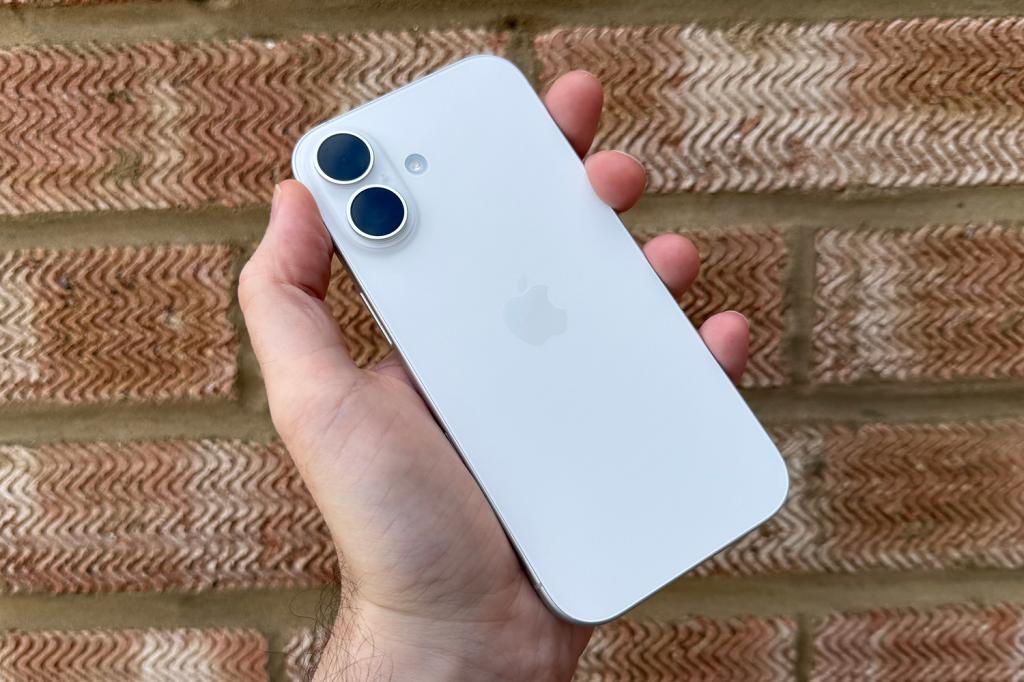
2. Apple iPhone 17
Stuff Verdict
The first standard iPhone in years that almost feels like an act of rebellion. Power. Clout. The least nosebleed-inducing price-tag. Almost no compromises. Boring? Sure. Brilliant? Absolutely.
Pros
- Superb display
- Hugely powerful
- Excellent ecosystem
- Meaningful camera upgrades
Cons
- No telephoto lens
- USB 2.0 data speeds
- iOS 26 design issues
| Apple iPhone 17 specs | |
|---|---|
| Screen | 6.3in 2622×1206 120Hz OLED |
| Processor | Apple A19 |
| RAM | 8GB |
| Storage | 256GB/512GB |
| Software | iOS 26 |
| Cameras | 48MP Dual Fusion rear, 18MP Centre Stage front |
| Battery | 3561mAh |
| Dimensions | 149.9×71.5×7.95 mm / 5.89×2.81×0.31in |
| Weight | 177g / 6.24 oz |
The iPhone 17 is Apple’s best all-rounder yet — and arguably the iPhone most people should buy in 2025. Despite being the entry-level iPhone, it delivers Pro-level performance without the eye-watering price or bulk. While its design hasn’t changed much, the new Ceramic Shield 2 improves scratch resistance, and the build feels as premium as ever.
The biggest win is the display. Apple’s finally upgraded the standard iPhone to a 120Hz OLED panel, matching the Pros for smoothness and adding a 1Hz always-on mode. During testing, scrolling felt far more fluid than on the iPhone 16, and brightness hit 3000 nits – clearly visible even in direct sunlight. The stereo speakers also pack a surprising punch when watching videos or gaming.
The dual 48MP camera system impresses in most conditions. In testing, macro shots showed noticeably better sharpness, and 1x photos looked rich and detailed. The lack of a telephoto lens remains the biggest gap versus the Pro models, digital zoom quickly loses quality beyond 2x, but 4K/60fps video recording and stabilisation keep it competitive.
Performance is stellar thanks to the A19 chip. Games like Assassin’s Creed ran smoothly (with only minor heating), and music production in Korg Gadget performed better than on an M1 iMac. Battery life easily lasts a day of mixed use. The main gripes? USB 2.0 speeds and iOS 26’s flawed “Liquid Glass” interface.
Despite that, Apple’s ecosystem remains unmatched for creative tools and premium apps. Unless you need a telephoto lens or ultra-thin bragging rights, the iPhone 17 nails the essentials. It’s powerful, practical and, for once, a sensible choice.
- Read more: iPhone 17 review
Best cheap iPhone
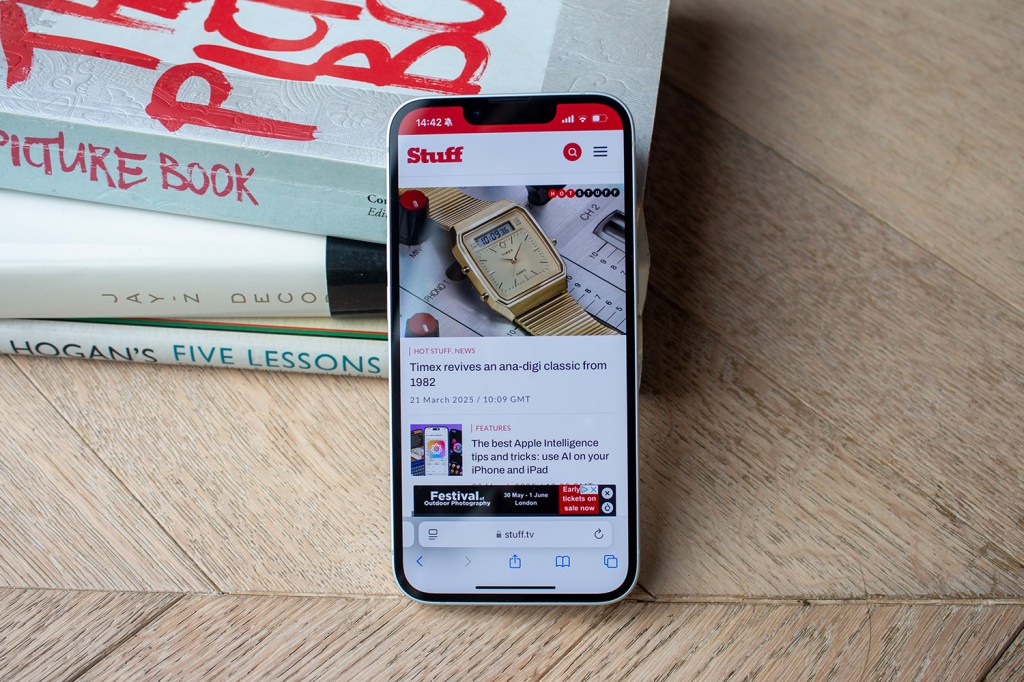
3. iPhone 16e
Stuff Verdict
A lightweight design, solid performance, consistent camera and brilliant battery make the iPhone 16e a great value option for those wanting a (slightly) less expensive iPhone.
Pros
- Lightweight and updated design
- Superb battery and performance
- Great single-lens camera
Cons
- No MagSafe
- 60Hz display
- Limited colour options
| Apple iPhone 16e review | |
|---|---|
| Screen | 6.1in, 2532 x 1170 OLED w/ 60Hz |
| CPU | Apple A18 |
| Memory | 8GB |
| Cameras | 48MP rear / 12MP front |
| Storage | 128/256/512GB on-board |
| Operating system | iOS 18 |
| Battery | 4005mAh |
| Dimensions | 147x72x7.8mm / 5.78×2.82×0.31in |
| Weight | 167g / 5.88ounces |
The iPhone 16e might not be Apple’s cheapest phone ever, but it strikes a smart balance between price and performance. At £599/$599, it’s not exactly impulse-buy territory – but it’s £200 less than the standard iPhone 16, and after weeks of testing it in the real world, we think it’s worth your attention.
Design-wise, it finally drags Apple’s entry-level offering into the modern era. Gone are the home button and chunky bezels. We’ve been using it on the go, and the flat edges, light 167g build and compact size made it a joy to handle – even one-handed on a packed train.
The OLED screen is vibrant and sharp, with deep blacks and rich colours. Watching Netflix on the commute looked great, even if the 60Hz refresh rate meant scrolling Twitter felt a bit less fluid than we’re used to on Android rivals. Outdoors in bright sun, it held up fine – not the brightest we’ve tested, but never unreadable.
We took the 16e on a long weekend trip and it easily lasted from breakfast to bedtime with around 40% battery left by the end of the day. That’s with maps, photos, Spotify and plenty of WhatsApp. Charging is slower than Pro models, but we didn’t find it annoying.
The single 48MP camera consistently delivered. Portraits of friends popped, low-light shots of city streets had detail without noise, and zoomed-in photos of our dog at the park looked great. Compared to the Pixel 8a, the iPhone 16e’s images had better colour accuracy and dynamic range.
No MagSafe is a downer – we missed using our car mount and magnetic charger. And yes, a 120Hz screen would’ve been nice. But for most people, the iPhone 16e nails the essentials and feels like a flagship in everyday use.
- Read more: iPhone 16e review
Best iPhone for design
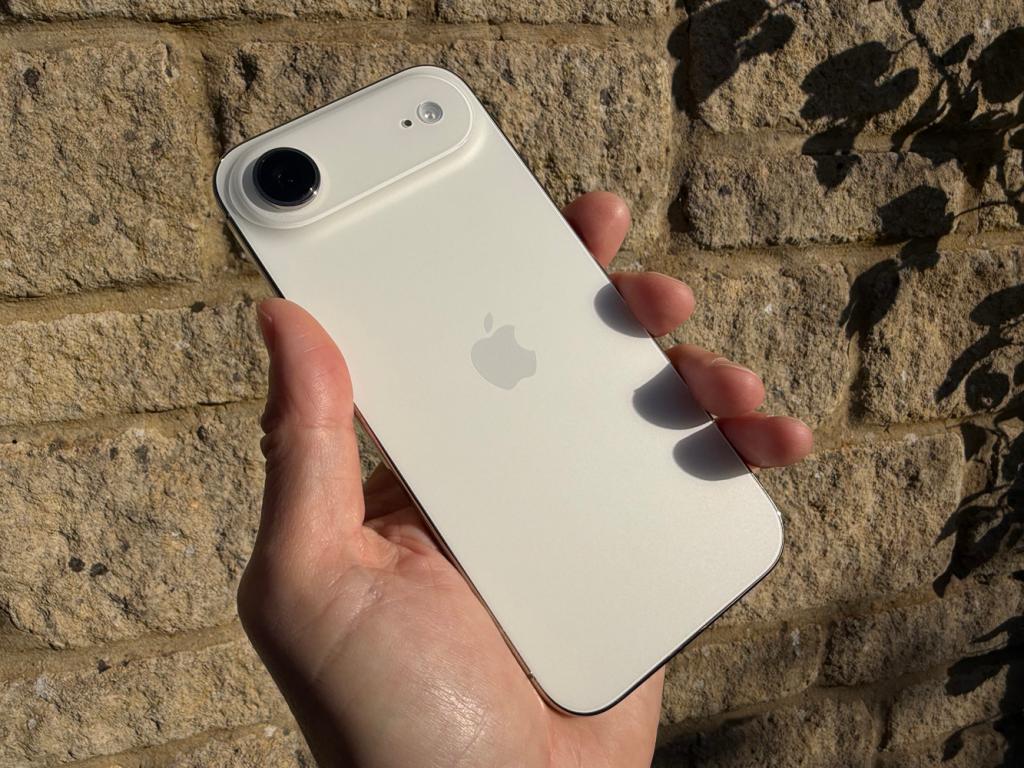
4. iPhone Air
Stuff Verdict
The iPhone Air is beautifully and painstakingly designed – but there’s a reason we love having several cameras on our flagship phones nowadays.
Pros
- A stunning new design for iPhone
- Wonderful large 6.5in display
- Pro-level hardware for the most part
- It’s super-thin but you do feel it’s robust
Cons
- The single camera just isn’t enough for anybody who values taking great pictures with their phone
- Battery life is bang average
- Mono speaker is just about OK
- Expensive compared to the vanilla iPhone 17
| Apple iPhone Air review | |
|---|---|
| Screen | 6.5in 2736×1260 120Hz AMOLED |
| CPU | Apple A19 Pro |
| Memory | 12GB |
| Cameras | 48MP Fusion rear, 16MP front |
| Storage | 256/512GB/1TB |
| Operating system | iOS 26 |
| Battery | 3149mAh (USB-C and wireless charging up to 20W) |
| Dimensions | 162x75x5.6 mm / 5.78×2.82×0.31in |
| Weight | 167g / 5.88ounces |
The iPhone Air is the first new iPhone model in years, so we were very excited to use it as our main phone during the review period. And, while we love its design, we don’t think it’s for everyone…
At just 165g and 5.6mm thick, it’s so light it almost disappears in your pocket, yet still feels reassuringly solid. The 6.5in OLED display is stunningly sharp and hits 3000nits of brightness in our tests – great for use outdoors. Performance is properly flagship too, thanks to the A19 Pro chip, matching the 17 Pro in benchmarks. But the thin design means it runs warm during long gaming sessions, and the 3149mAh battery just about lasts a full day – we hit 20% by the evening more than once.
The single 48MP camera delivers crisp shots in daylight, but we really missed the ultrawide and telephoto options from the 17 series. On a work trip, we had to borrow a Pro model to fit everyone into a group photo, which says it all. Audio also takes a hit – the mono speaker sounds flat next to the stereo setup on pricier models.
If you value portability and design above all else, the iPhone Air is a lovely, pocket-friendly slice of Apple hardware. But if photography, battery life, or versatility matter more, the iPhone 17 remains the smarter buy.
- Read more: iPhone Air review
Best previous-generation iPhone
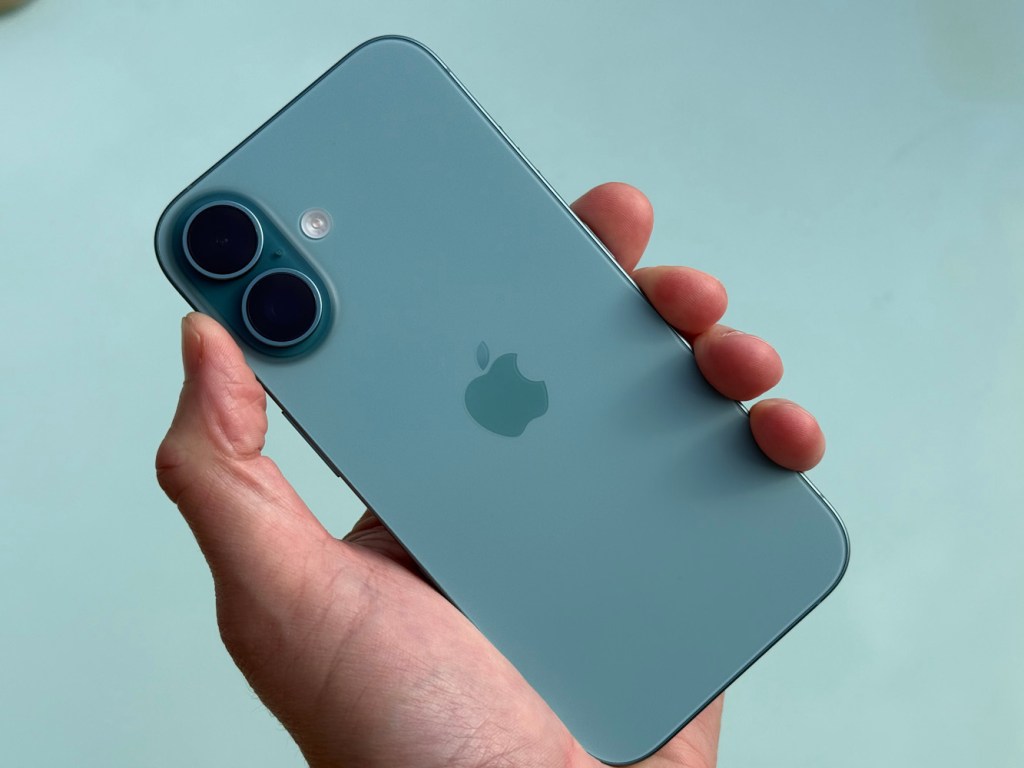
5. iPhone 16
Stuff Verdict
A pleasing update to a winning formula that’s a much more appealing combo than spending more to go Pro.
Pros
- Makes the Pro look poor value
- The telephoto is very welcome
- Great that Camera Control has made it to the standard model as well as the Pro
- Long-lasting battery
Cons
- We’d like some brighter colors please
- 60Hz refresh rate is old news
- Camera Control can be fiddly
| Apple iPhone 16 specs | |
|---|---|
| Screen | 6.1in 2556×1179 Super Retina XDR OLED HDR at 460ppi |
| CPU | Apple A18 |
| Memory | 8GB |
| Cameras | 48MP ƒ/1.6 main, 12MP ƒ/2.2 ultra wide rear; 12MP ƒ/1.9 front |
| Storage | 128GB/256GB/512GB |
| Operating system | iOS 18 |
| Battery | 3561mAh |
| Dimensions | 148x72x7.8mm / 5.81 x 2.82 x 0.31in |
| Weight | 170g / 6oz |
Apple’s iPhone 16 was launched in 2024, so if you’re looking to save a little money and don’t need all of the latest iPhone 17 features, the 16 is a solid option. It still feels like a solid mix of refinement and fresh features.
What catches our eye right away is the new Camera Control. It’s great to see Apple bringing this customisable shutter button to the standard models – not just the Pros. We like that it opens the camera instantly and lets us tweak settings with ease, whether we’re zooming in or adjusting the tone. The 48MP main camera with 2x telephoto is a definite step up, and we’re loving the range it offers for our shots.
Performance-wise, Apple’s A18 chip is blazing fast, with no lag even when we’re multitasking heavily. The slightly larger battery gives us more screen time, enough to comfortably last a day and then some. However, we’re let down by the lack of ProMotion’s smooth 120Hz refresh rate; a display like this really deserves better, especially when Apple’s competitors have been stepping up in that area.
iOS 18 has some standout tweaks, too. With RCS messaging and the reworked Control Center, we’re finding it more customisable than ever. All in all, the iPhone 16 impresses with many Pro-like features, even if Apple Intelligence isn’t here to wow us just yet. For the price, it’s a strong, well-rounded package.
- Read more: iPhone 16 review
Best previous-generation Pro iPhone

6. Apple iPhone 16 Pro Max
Stuff Verdict
Not an update that makes you want to throw a party, but the iPhone 16 Pro Max’s power, camera and battery life are so good it’s hard to imagine anyone not being quietly impressed.
Pros
- Ludicrously powerful
- Impressive new camera smarts
- Outstanding battery life
Cons
- Unfinished software
- Now even bigger and bulkier
- Boring colours
| Apple iPhone 16 Pro Max specs | |
|---|---|
| Screen | 6.9in 2868×1320 OLED HDR at 460ppi |
| CPU | Apple A18 Pro |
| Memory | 8GB |
| Cameras | 48MP ƒ/1.78 main, 48MP ƒ/2.2 ultra wide, 12MP ƒ/2.8 telephoto (5× optical zoom in) rear; 12MP ƒ/1.9 front |
| Storage | 256GB/512GB/1TB on-board |
| Operating system | iOS 18 |
| Battery | 4685 mAh |
| Dimensions | 163×77.6×8.25mm / 6.42×3.06×0.32in |
| Weight | 227g / 7.99oz |
Similar to the iPhone 16 above, this has now been replaced by the 17 Pro, but the iPhone 16 Pro Max still hits familiar marks – powerful, huge display, killer battery – but it’s also clear Apple is playing it safe with last year’s model. Yes, it’s incredibly fast, boasting Apple’s A18 Pro chip, which breezes through high-end games and heavy multitasking. But what sets it apart, truly? Sure, it has a 6.9-inch display with barely-there bezels, and that’s stunning. Yet, it doesn’t exactly make us want to celebrate in the streets.
One thing we’re really enjoying here is the improved camera, especially for close-ups and action shots. The 48MP ultrawide snaps are razor-sharp, and with the new 5x optical zoom, we’re capturing shots that would’ve been a pixelated mess on older models. We’re also having fun with the new slow-motion effects; there’s something quite epic about watching everyday moments in cinematic, Matrix-esque slo-mo. Plus, the four-mic array and audio controls give videos that extra polish.
But all that goodness has a few trade-offs. This thing is bulky – it’s noticeably bigger and heavier than the last Pro Max. If you’re coming from an iPhone 13 Pro Max, you’ll feel it. And while the new titanium frame is supposed to be tougher, that extra durability won’t stop it from shattering if it takes a serious tumble.
As for the much-touted Apple Intelligence feature, it’s almost there. This year’s iOS 18 gives us a glimpse, but full AI functionality is still waiting in the wings. The new Camera Control button is cool, but takes some getting used to. If you’re looking to save a few quid and can live without a couple of these extras, the standard iPhone 16 might actually suit you better.
- Read more: iPhone 16 Pro Max review
Best iPhone for kids
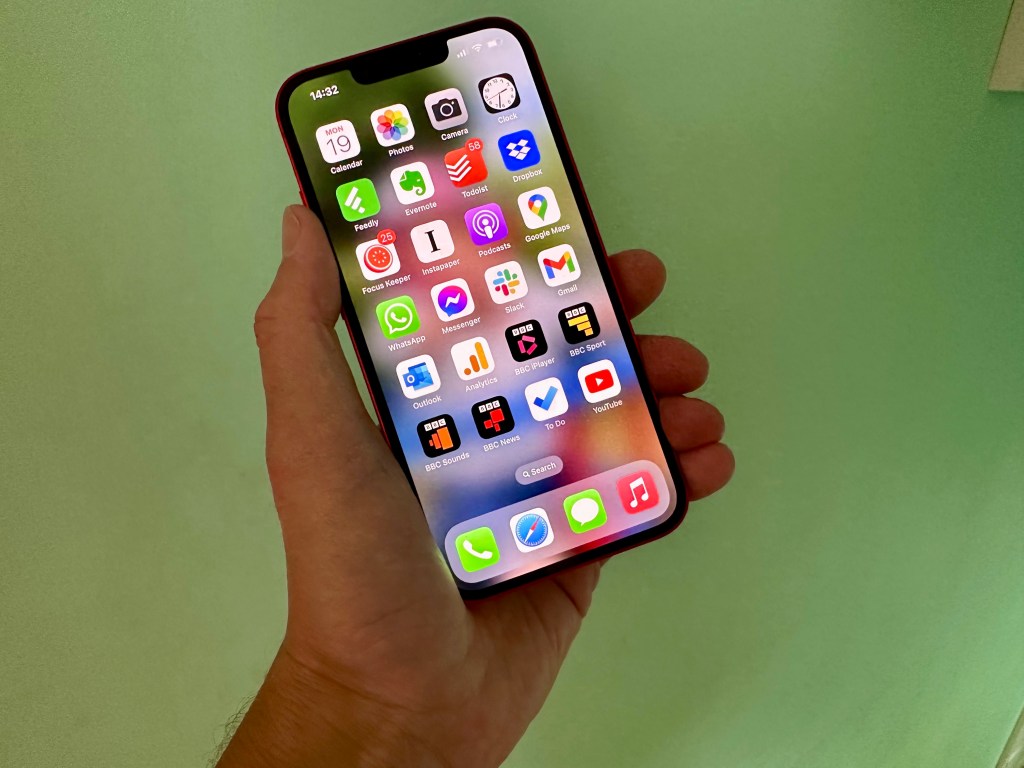
7. iPhone 14
Stuff Verdict
The Apple iPhone 14 is a superb smartphone even though the minimal hardware upgrades take the shine off. It could be a great first iPhone.
Pros
- Still an incredible smartphone
- Brilliant battery life gets a bit better
Cons
- Last year’s Pro hardware
- Wireless charging slow by modern standards
| iPhone 14 specs | |
|---|---|
| Display | 6.1in Super Retina XDR OLED, 1170 x 2532 pixels |
| Processor | Apple A15 Bionic |
| Memory | 6GB |
| Storage | 128GB, 256GB, 512GB |
| Software | iOS 16 |
| Camera | 12MP+12MP (rear) 12MP (front) |
| Dimensions | 146.7 x 71.5 x 7.8 mm / 5.78 × 2.81 × 0.31 in |
| Weight | 172 g / 6.07 oz |
If you want to get your child their first iPhone but don’t fancy spending big on the latest iPhone 17 – because, let’s be honest, there’s a good chance it’ll get dropped, cracked, or left on a bus – the iPhone 14 is a solid choice. It still looks modern, runs the latest iOS, and offers plenty of power for games, social media, and schoolwork.
Under the hood, it uses the same A15 Bionic chip as the iPhone 13, which is still fast enough for pretty much anything a teenager might throw at it. You also get the same trio of storage options and a dual-camera setup on the back. That said, the iPhone 14’s slightly wider aperture and improved image processing mean photos come out brighter and sharper, especially in low light.
Apple also added emergency satellite communication – a feature that lets you contact help when you’re out of mobile range. It’s not something most people will need every day, but it’s reassuring to have if your kid likes hiking, camping, or just tends to wander off with no signal.
- Read more: Apple iPhone 14 review
How to choose the best iPhone for you
Buying an iPhone might seem simple – you walk into an Apple Store, pick the latest model, and you’re done. But it’s not that straightforward. With several models still on sale, each with different features and prices, it’s worth thinking through what you actually need before you spend three or four figures on something that’ll live in your pocket.
Start with your budget. Apple’s line-up ranges from the relatively affordable iPhone e to the ultra-premium iPhone 17 Pro Max. The good news is that even older models like the iPhone 14 or 15 still perform brilliantly and receive software updates for years. You’re paying for more than just specs – things like screen quality, camera tech, and build materials separate the cheaper models from the pricier ones.
You’ll be using your phone constantly, so it needs to feel right in your hand. The regular iPhones tend to strike the best balance of screen space and comfort, while the Max versions are massive and great for watching films, but tricky to pocket. If you prefer something smaller, the old SE is an option, though it’s showing its age in design.
All iPhones are fast, but the latest chips, like the A19 Pro, are designed for heavier tasks such as gaming, editing video and AI features. If you mainly browse, message, and stream, an older A16 or even A15 chip will serve you fine.
Battery life varies across models: larger iPhones generally last longer, while the compact ones sacrifice stamina for size.
Apple’s camera systems are some of the best, but you don’t need a Pro model to take great photos. The biggest differences are in low-light performance, zoom range, and video features. If you care about photography, look for models with larger sensors and optical zoom lenses. For everyday snaps, the standard dual-camera setup is more than enough.
Finally, Apple no longer offers expandable storage, so pick wisely. 128GB is the practical minimum, especially if you shoot video or download lots of apps. Heavy users or creators should go for 256GB or more, because upgrading later isn’t possible.
Frequently asked questions
iPhone models explained
Apple’s iPhone line-up can be confusing, especially with all the different names. Here’s a quick breakdown of what each one actually means.
The SE is Apple’s budget option. It looks like an older iPhone, complete with a Home button. It’s ideal if you just want an iPhone that runs iOS smoothly without fancy extras. Although it’s now been discontinued.
The SE was replaced by the ‘E’. This is Apple’s new budget-focused member of the family. It’s a more affordable, modern option that sits below the main model in price but keeps many current features (OLED display, recent chip, and decent camera).
Then you have the standard iPhone. It’s usually the best balance of price, power, and features. You get a bright OLED screen, dual cameras, and the latest software, but miss out on the high-end camera tricks and premium build of the Pro.
Apple used to offer a ‘Plus’ version of the regular model, which is bigger. You get a larger display and slightly better battery life, with the same cameras and performance.
Next, you get the Pro models. These are for people who want top-tier performance and camera quality. They use higher-end materials, add features like ProMotion 120Hz displays, and pack triple-lens cameras with telephoto zoom.
Finally, there is the Pro Max, which takes everything from the Pro and makes it bigger (both physically and in price). You get the best cameras, the biggest screen, and the longest battery life of any iPhone. Great if you love watching films or editing photos on the go.
How we test smartphones
We’ve tested every phone on this list ourselves, so you can trust our picks. We treat each handset like a daily driver – not a staged demo – and that makes a big difference to the recommendations we give.
Typically, we spend a week or more with each phone, using it for calls, streaming, navigation, photos, messaging and gaming. That hands-on time lets us spot real-world strengths and quirks that a quick bench test would miss. We stress-test performance by multitasking and running demanding games like Genshin Impact or Call of Duty: Mobile, check battery life across different usage patterns, and time how long each device actually takes to charge from 0 to 100%.
Displays get judged for brightness, colour accuracy and outdoor readability, but also for how they handle different media. We watch HDR shows on Netflix, scroll through Instagram’s bright feeds, stream YouTube videos in varying resolutions and browse photos to see how punchy – or natural – colours look. We also note how smooth adaptive refresh rates feel when scrolling or gaming, and whether viewing angles hold up under harsh light.
Camera testing includes daylight, low-light and video scenarios – everything from shooting portraits in busy city streets to night scenes and 4K stabilised clips – to see how lenses, autofocus and image processing behave. We also pay attention to build quality (does it scratch easily?), speaker performance when playing music or YouTube, and any software oddities, like app crashes or slow animations. We look at how clean the interface feels, whether there’s bloatware, and how strong the manufacturer’s update promise really is.
Our reviews cover the essentials separately – battery, screen, camera, performance and everyday usability – so you get a clear picture of what owning the phone will be like, not just what its spec sheet says. The goal is simple: help you buy a phone that actually fits your life.
For more information on Stuff’s rating and review process, read our page on how we test products.
Recent updates
- 30th October 2025: We’ve added the iPhone 17, iPhone 17 Pro and iPhone Air. We’ve removed the discontinued models, such as the iPhone 15 Pro Max and iPhone SE. We also added a frequently asked questions section.

